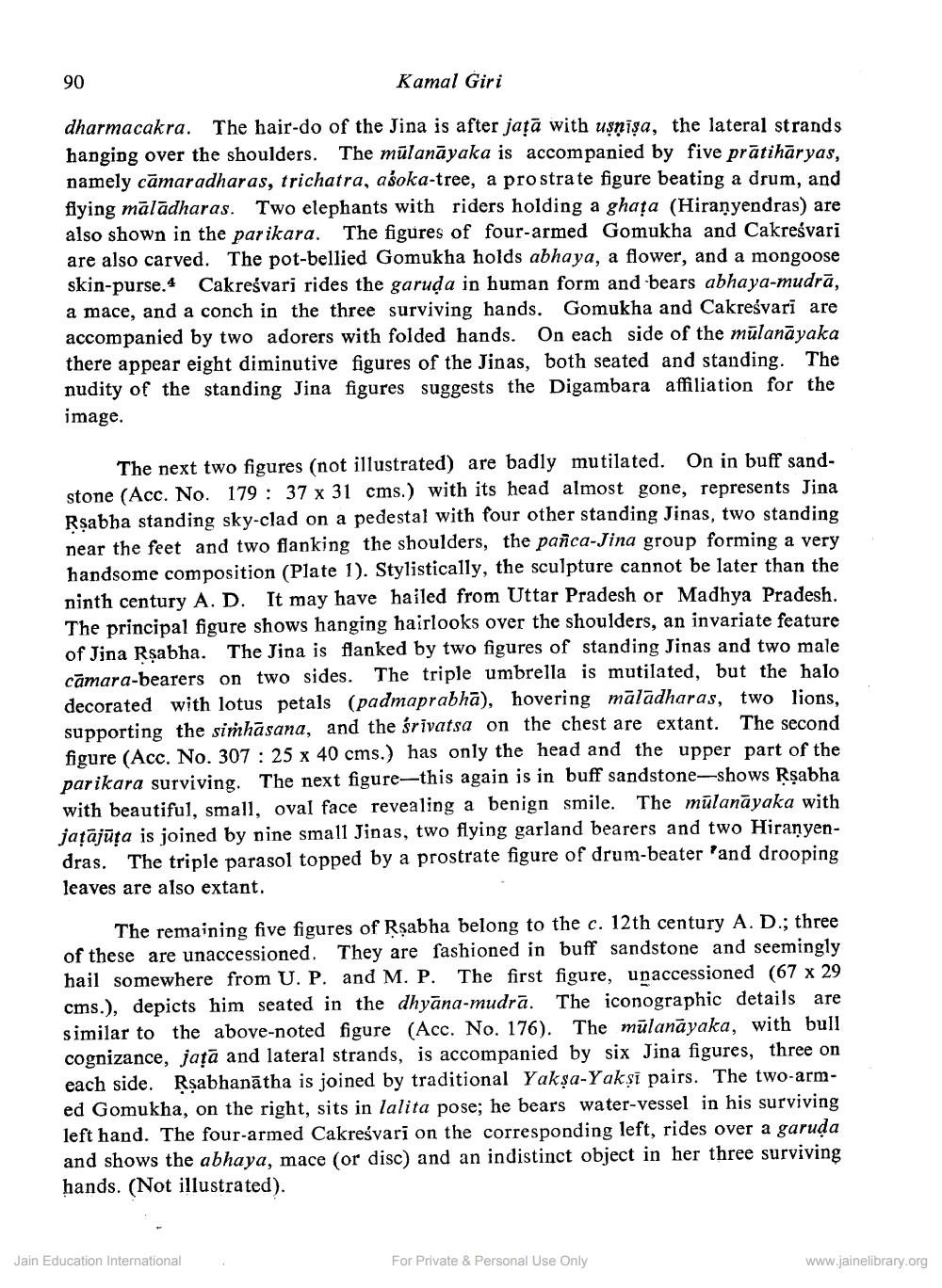Book Title: Jaina Sculptures in Bharata Kala Bhavan Author(s): Kamalgiri Publisher: Z_Aspect_of_Jainology_Part_2_Pundit_Bechardas_Doshi_012016.pdf View full book textPage 2
________________ 90 Kamal Giri dharmacakra. The hair-do of the Jina is after jață with uşnīşa, the lateral strands hanging over the shoulders. The mūlanāyaka is accompanied by five prātihāryas, namely cāmaradharas, trichatra, aśoka-tree, a prostrate figure beating a drum, and flying mālādharas. Two elephants with riders holding a ghața (Hiranyendras) are also shown in the parikara. The figures of four-armed Gomukha and Cakreśvari are also carved. The pot-bellied Gomukha holds abhaya, a flower, and a mongoose skin-purse.4 Cakreśvari rides the garuda in human form and bears abhaya-mudrā, a mace, and a conch in the three surviving hands. Gomukha and Cakreśvari are accompanied by two adorers with folded hands. On each side of the mūlanāyaka there appear eight diminutive figures of the Jinas, both seated and standing. The nudity of the standing Jina figures suggests the Digambara affiliation for the image. The next two figures (not illustrated) are badly mutilated. On in buff sandstone (Acc. No. 179: 37 x 31 cms.) with its head almost gone, represents Jina Rsabha standing sky-clad on a pedestal with four other standing Jinas, two standing near the feet and two flanking the shoulders, the panca-Jina group forming a very handsome composition (Plate 1). Stylistically, the sculpture cannot be later than the ninth century A. D. It may have hailed from Uttar Pradesh or Madhya Pradesh. The principal figure shows hanging hairlooks over the shoulders, an invariate feature of Jina Rsabha. The Jina is flanked by two figures of standing Jinas and two male camara-bearers on two sides. The triple umbrella is mutilated, but the halo decorated with lotus petals (padmaprabhā), hovering mālādharas, two lions, supporting the simhāsana, and the srivatsa on the chest are extant. The second figure (Acc. No. 307 : 25 x 40 cms.) has only the head and the upper part of the parikara surviving. The next figure—this again is in buff sandstone-shows Rşabha with beautiful, small, oval face revealing a benign smile. The mūlanāyaka with jațājūța is joined by nine small Jinas, two flying garland bearers and two Hiranyendras. The triple parasol topped by a prostrate figure of drum-beater 'and drooping leaves are also extant. The remaining five figures of Rşabha belong to the c. 12th century A. D.; three of these are unaccessioned. They are fashioned in buff sandstone and seemingly hail somewhere from U. P. and M. P. The first figure, unaccessioned (67 x 29 cms.), depicts him seated in the dhyāna-mudrā. The iconographic details are similar to the above-noted figure (Acc. No. 176). The mūlanayaka, with bull cognizance, jațā and lateral strands, is accompanied by six Jina figures, three on each side. Rşabhanātha is joined by traditional Yakşa-Yaksi pairs. The two-armed Gomukha, on the right, sits in lalita pose; he bears water-vessel in his surviving left hand. The four-armed Cakreśvari on the corresponding left, rides over a garuda and shows the abhaya, mace (or disc) and an indistinct object in her three surviving hands. (Not illustrated). Jain Education International For Private & Personal Use Only www.jainelibrary.orgPage Navigation
1 2 3 4 5 6 7 8 9 10 11 12 13 14 15
